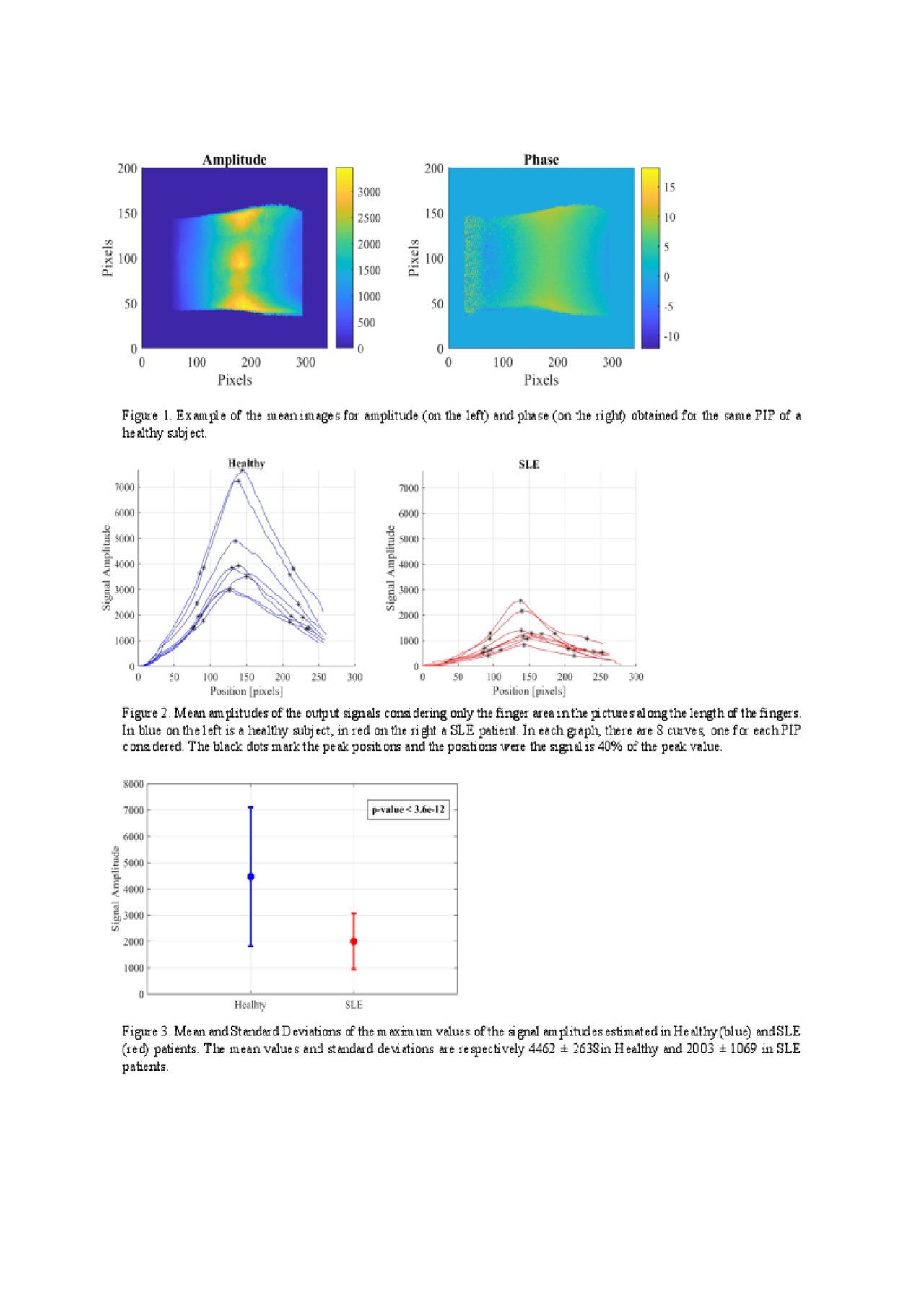Session Information
Session Type: Poster Session (Monday)
Session Time: 9:00AM-11:00AM
Background/Purpose: 95% of the people with SLE experience joint pain, stiffness and swelling at some time during their illness. It is currently difficult to both diagnose and estimate the severity of lupus arthritis.This studyexplores the clinical utility of frequency-domain optical transmission (FDOT) measurements to distinguish affected finger joints from healthy ones.
Methods: The FDOT system is operated at a frequency of 600MHz. The laser diode produces a 1-mm diameter beam at 670nm light with a power of 8mW. Transmitted light intensity is measured using an ICCD camera operated in homodyne mode.
|
|
For data acquisition, the laser beam is guided to 11 positions, separated by 2 mm from each other, on the top of the finger, scanning along a sagittal plane in the forward direction with a modulation frequency of 600 MHz. PIP II -V of both hands were scanned. The time required to set-up the system and scan a single finger was about 2 min. 10 patients with SLE with active arthritis were evaluated (9 women, mean age 42 ± 9.1 years). All patients had arthritis by physical exam: swelling, tenderness and pain in each finger joint. 4 healthy controls were also examined (3 women, mean age 28.7 ± 4.4 years). A total of 80 fingers from SLE patients and 32 fingers from healthy volunteers were analyzed.
Results: The raw data obtained consisted in 16 pictures for each of the 11 source positions for a total of 176 images per finger. The data was processed using a fast Fourier transformation, obtaining values for the amplitude, phase and the DC components for all source positions. An example of the 2D distribution of the mean values for amplitude and phase for a healthy PIP subject can be seen in Figure 1. From the 2D images, a linear mean value of the amplitudes and phases along the length of the finger was calculated. An example of the amplitude behaviors from healthy joints and SLE joints are shown in Figure 2.
The maximum values of the signal amplitudes in healthy volunteers is considerably higher (4462 ± 2638) than in SLE patients (2003 ± 1069). An ANOVA analysis (using MATLAB embedded function anova1) shows that these differences are statistically significant between healthy and SLE patients (p value < 3.6e-11), as shown in Figure 3.
From the ROC curve analysis, the best cut-off plane holds a sensitivity of 100% and a specificity of 80% to distinguish between joints of Healthy volunteers and SLE patients, with an area under the curve (AUC) of 0.9.
Conclusion: FDOT can differentiate healthy joints from those of SLE patients. We foundstatistically significant differences between the max signal amplitudes of the two groups. The ROC analysis showed high sensitivity and specificity. Further development of this technology is likely to improve the evaluation of SLE arthritis in clinical trials and practice.
To cite this abstract in AMA style:
Askanase A, Van Biema F, Marone A, Kim Y, Chen T, Kapoor T, Geraldino L, Gartshteyn Y, Hielscher A. New Imaging Modality to Evaluate Arthritis in Lupus Based on Frequency-domain Optical Transmission [abstract]. Arthritis Rheumatol. 2019; 71 (suppl 10). https://acrabstracts.org/abstract/new-imaging-modality-to-evaluate-arthritis-in-lupus-based-on-frequency-domain-optical-transmission/. Accessed .« Back to 2019 ACR/ARP Annual Meeting
ACR Meeting Abstracts - https://acrabstracts.org/abstract/new-imaging-modality-to-evaluate-arthritis-in-lupus-based-on-frequency-domain-optical-transmission/

